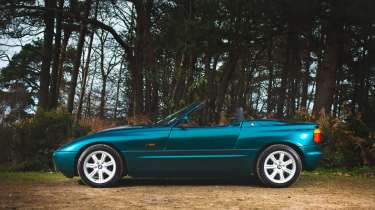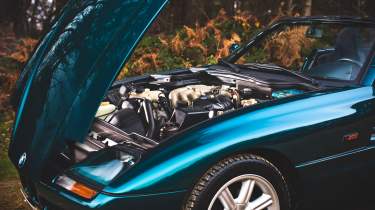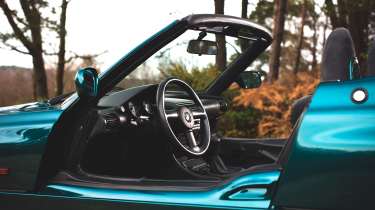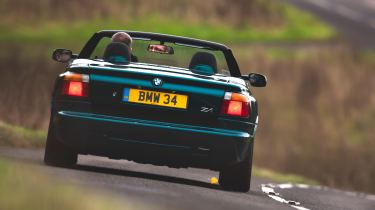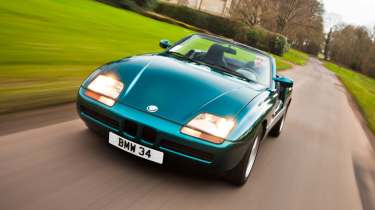BMW Z1 (1989 – 1991) review – there's more to BMW's first Z car than its famous gimmick
The car that started a new era of BMW roadsters is best known for its weird and (not so) wonderful doors. But there's more to this quirky modern classic than that
Should we have been surprised when BMW produced such left-field models as the i3 and i8? Granted, alongside its three-box saloons and the X-series range of 4x4s, both the i3 and i8 appeared to be from a time only the Bavarian engineers had visited; one even beyond our own in the mid-2020s, from over a decade in the past, but it wasn’t as if the company didn’t have previous form when it came to delivering the unexpected.
Ignoring the obvious motorsport specials such as the CSL Batmobiles and E30 M3s, BMW’s back catalogue is populated with intriguing and eclectic entries, going as far back as 1956 with the gorgeous 507 Roadster. In the ’70s, the M1 married the BMW M5’s stonking 3.5-litre straight-six with Giugiaro’s exotic automotive wedge. The ’90s saw the company discard its executive-saloon-car cloak and deliver the breadvan M Coupe, before once again calling on an M5’s engine, this time the 400bhp V8, to slot into a sleek, retro-style roadster called the Z8.
But in driving the Z1, we visit the 1980s, the decade fashion forgot and a time when BMW’s designers really broke free from their three-box straitjackets. Even now, over 35 years on, it’s hard to imagine how a plastic-bodied, two-seater roadster with doors that disappeared into the sills ever made it past the bean counters, let alone the product managers brought up on a diet of 3, 5 and 7-series.
Even sat next to the sci-fi i8, this ’80s wedge is a captivating sight that manages to pull off that rare trick of looking at least half its age. Park it in a marble-floored BMW showroom today and it wouldn’t look out of place alongside the current Z4. It might outshine it though…
Head-on, the nose has a hint of BMW M1 about it with its shallow double-kidney grille, while those front wings climb at quite an angle to reach the base of the letterbox windscreen and those unhinged (metaphorically and literally) doors. From the rear, the stumpy tail looks like an abrupt cut was accidentally made on the clay styling buck and continued through to production with no-one noticing. In fact, this was more than just a funky design element.
> BMW i8 (2014-2020) – review, history, specs, and buyer’s guide
The Z’s undertray is flat, and the exhaust silencer and rear valance were designed as aerodynamic components to reduce turbulence and rear lift. In 1989 it was a neat solution that avoided having to have an unsightly wing glued to the bootlid.
By today’s standards the Z1 looks tiny, especially when an R56 Mini is within spitting distance and casting its shadow. The roadster’s wheelbase is over half a metre shorter than that of even a second-generation 1-series, and the Z1 is 25 per cent shorter overall, too. In today’s world, where bigger is presumed to be better, the Z1 is a reminder of a time when good things came in small packages.
The Z1 project was headed by one Ulrich Bez, a name familiar to Aston Martin and Porsche fans alike; he left BMW the year before the Z1 went on sale in 1989 to join Porsche and bring the 993-series 911 to market, before hotfooting it to Aston. Harm Lagaay (yes, another who moved on to Porsche) was responsible for the design. A concept was shown in 1986 and 12 months later production was confirmed, with BMW announcing it had received 5000 pre-orders for the car, a figure which by 1988 had reportedly grown to 35,000.
In fact, when the two-year production run ended in 1991, just 8000 Z1s had been built, all left-hand drive except for the very last. With BMW unable to get the car through the US’s stringent federal regulations, the Z1’s sales potential was severely restricted. The lion’s share of sales were in Germany, where more than 6000 examples found homes.
> Used BMW M3 CS (E46, 2005 - 2006) review – BMW M's forgotten modern classic
Take-up can’t have been helped by the list price – a huge £37,000 when what was arguably its closest rival, the turbocharged, front-wheel-drive Lotus Elan, cost £17,850. So what did you get for your £37k? Beneath that sleek bonnet was an E30 325i’s M20B25 170bhp straight-six, tilted 20 degrees to fit. It was located almost 30cm further back in the engine bay compared with an E30 to give a 49/51 per cent front/rear weight distribution.
The 325i’s Getrag five-speed gearbox was also used, as was the front suspension – MacPherson struts, coil springs and an anti-roll bar. It was with its rear suspension that the Z made its mark, however. Called the Z axle, it was BMW’s first multi-link layout and a blueprint for future BMW chassis, starting with the E36 3-series that would be launched soon after.
It wasn’t only the Z1’s rear suspension that was pushing BMW’s engineering boundaries. The outer body panels were plastic and, BMW claimed, could be replaced within 40 minutes. The company even encouraged owners to order a spare set of panels in a second colour so they could own ‘two’ Z1s.
The car’s strength came from a steel monocoque underbody with a bonded plastic floor and a tubular steel bar running behind the dashboard, linking with an integral roll-over hoop running up the A-pillars and across the top of the windscreen. If you were so inclined you could drive your Z1 with no outer body panels at all.
> BMW Z4 Handschalter 2025 review – manual improves Munich's Boxster rival
This isn’t the first time I’ve driven a Z1, but it is the first time without a colleague with years of Z1 experience on hand to show me how to open the door. Somewhere on BMW’s CCTV is footage of a confused hack searching Google for Z1 door opening instructions. Where would we be without smartphones? Still stood in a car park, looking at a Z1 and wondering how to get into it, I suspect.
The answer is to push the door lock into the body panel and watch as the window starts to open. What follows is a hefty clunk as the door begins its party piece and slides down into the sill. It’s gone in less than ten seconds and, with the roof up, it leaves a rather small aperture and a high, wide sill – a consequence of the crash protection engineered into the lower half of the car – to negotiate. Think Lotus Elise levels of entry and exit dignity.
It doesn’t get much easier with the roof off, thanks to the small cockpit and the fact the gorgeous three-spoke steering wheel (note the perfect thickness, BMW of today) always seems to be where you want to put your right leg. I would like to claim I mastered a technique that made me look like a pro; instead I looked like a 40-year-old with all the suppleness of an ironing board trying to get into a small sports car.
When you drive an old car, you spend a great deal of time trying to imagine how it would have felt to own it new. So, in your mind’s eye, you picture it among the humdrum traffic of the day and, crucially, alongside its competitors. For the Z1, the competition came in the shape of the Elan, the original MX-5 and the TVR S. On looks, the Z1 was the one that would stop you in your tracks. It wasn’t the quickest, though; the 2.5-litre six delivered a healthy (for the time) 164lb ft but it didn’t arrive until 4300rpm. Indeed, the biggest criticism fired at the Z1 at the time was its lack of performance and the need to drive it everywhere like your shoulder-pads were on fire.
A top speed of 137mph was respectable, but a 0-62mph time of 7.9sec was way off the pace of the Elan and the TVR (both under 7sec). The Z1’s performance wasn’t the only thing contemporary road testers found to grumble about, though. They, like me, found getting in and out an undignified scramble – and then there was that huge price.
As a classic car, its performance and original price are less relevant (£60k is top money for a Z1 today). Once you’re inside and sat on those sculpted bucket seats, it feels every inch the tight, compact sports car BMW claimed it to be.
That obstructive steering wheel is a delight to look at and hold, its three spokes and leather-covered rim the perfect diameter and thickness and a far cry from today’s obese BMW rims. If you’re expecting a traditional BMW instrument layout with two big central dials flanked by an auxiliary gauge either side, you might be disappointed by the four motorbike dials BMW used instead, but in fact their minimalist look suits the car perfectly.
It’s hard to be objective about a car’s performance when it’s celebrating its 25th birthday, but it doesn’t take long to understand where those contemporary road-testers were coming from with regards to the Z1’s pace, or lack thereof. The straight-six soundtrack is smooth and mechanical, this 37,000-mile example ticking over as you’d expect a well-oiled Bavarian machine to do.
There’s that distinctive tat-tat-tat top-end inherent in all M20B25 motors, though it soon becomes background noise as you work through the conventional H-pattern Getrag gearbox, waiting for the pace to pick up. But it never really arrives. As the revs climb, the engine note takes on a muscular edge, but the matching performance never materialises.
All is not lost for the baby Z-car, however. The steering is direct and accurate and the chassis is neatly tied down, allowing you to maintain a decent pace and avoid having to scrub off the speed you’ve worked hard to build. Over crests it reacts all-of-a-piece, its short wheelbase moving around as one, absorbing the ridges of a British B-road with real suppleness. It’s a fun and engaging car to enjoy at a decent pace. Is it a car you must drive before you die? No, but then no-one ever claimed it was.
The Z1 does have one big trick up its sleeve, of course: those doors. Even with them lowered, the high sill cocoons you so there is no sense of vulnerability as you skate along with the road rushing below you. Think Caterham Seven with the side-screens removed and you’re not far off.
Despite the reservations about its performance and the contortions required to get in and out of it, the Z1 has undeniable classic car appeal and would raise a smile every time you saw it parked in your garage. We’re still not quite sure how the engineers got it past the accountants, but we’re mighty glad they did.
BMW Z1 specs
| Engine | In-line 6-cyl, 2494cc |
|---|---|
| Power | 170bhp @ 5800rpm |
| Torque | 164lb ft @ 4300rpm |
| Transmission | Five-speed manual, rear-wheel drive |
| Weight (kerb) | 1460kg (118bhp/ton) |
| 0-62mph | 7.9sec (claimed) |
| Top speed | 137mph (claimed) |
| Price new | £37,000 (1989) |
| Value now | From £40k |



